Armenian Crown: The Gandzasar Code
Gandzasar, with its significance as the seat of Armenian kings and bishops, is also at the center of a great historical riddle that connects the present world with royal families of medieval Armenia, patriarchs from the Old Testament, and epic forefathers of the Armenian people.
When Armenians want to emphasize the importance of Nagorno Karabakh, they say: “after all, the crown of the ancient Kingdom of Armenia is in Nagorno Karabakh.” Furthermore, the image of the Armenian Crown features on the state seal of the Nagorno Karabakh Republic, soaring above the head of the Eagle of Artsakh. What does this mean? The word crown in this context is used symbolically, as the country’s long-lost link to Armenia’s royalty and to its semi-mythical eponymous ancestors.
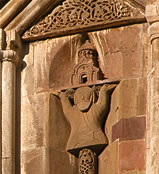
Carving on the drum of the Cathedral of St. John the Baptist believed by some to be depicting Grand Prince Hasan Jalal Vahtangian, Lord of Khachen.
The above-mentioned connections run through the bloodline of the Hasan-Jalalians: a family of direct descendents of Hasan Jalal Vahtangian, the prince who in the thirteenth century built the Cathedral of St. John of the Gandzasar Monastery and ruled Artsakh as one large Armenian kingdom. Not surprising, Nagorno Karabakh—historical Artsakh—is a land of particular importance to the Armenian people and to all those interested in enduring mysteries of the ancient world.
In recent times, several bestselling authors tried to explore similar connections. In The Da Vinci Code, the American writer Dan Brown masterfully concocts an intelligent thriller that marries the gusto of a mysterious international murder with a collection of fascinating esoteria culled from 2,000 years of Western history.
In Brown’s book, Harvard symbologist Robert Langdon discovers that the enigmatic riddle he works to solve leads to a trail of clues hidden in the works of Da Vinci. The Italian genius painter and inventor is portrayed by Brown as one of the principles of the so-called Priory of Zion—a centuries-old secret society established to preserve the Holy Grail. The world’s biggest mystery, the book contends, is that the Holy Grail is not a physical chalice from the Christ’s Last Supper, but a metaphor to describe a woman, namely Mary Magdalene, who carried Jesus Christ’s child in her womb. In the text, Professor Langdon joins forces with a gifted French cryptologist, Sophie Neveu who turns out to be none other than the very direct descendent of Jesus Christ and Mary Magdalene.
The Da Vinci Code is a fantasy reflecting allegations found in some apocryphal Christian texts. In contrast, the Hasan-Jalalians are no fictional characters. They were and are real living individuals, who claim a direct blood lineage to Armenia’s Bagratid kings and Patriarch Hayk Nahapet, the epic forefather of the Armenians. And through Hayk, they claim a connection to none other than the Old Testament’s Japheth and his father Noah.
It seems that the Gandzasar Monastery is therefore destined to turn into an international hotspot that may soon rival The Da Vinci Code’s Chapel in Scotland.
The Hasan-Jalalians: The Royal Connection
Grand Prince Hasan Jalal Vahtangian’s ancestry is directly linked to royal and nakharar (highest-order noble) dynasties of ancient Armenia.
The works of several medieval Armenian authors show that in the male line Hasan Jalal directly relates to the Arranshahik princes and kings of Syunik (Armenia’s province bordering on Artsakh from the west). Through his mother Khorishah, sister of the Zakarian princes who liberated Armenia from Seljuk Turks, Hasan Jalal related both to the Bagratuni (Bagratid) kings of Ani, and the Artsruni kings of Vaspurakan (whose domain was in the region around Lake Van). In addition, through his Mihranian ancestors from Artsakh’s northern district of Gardman, Hasan Jalal could trace his roots to the Sassanid imperial dynasty of Persia. Modern scholars, such as Robert Hewsen, a US-based specialist in medieval Artsakh, confirm these findings. [1]
The above-mentioned linkages show that modern Hasan-Jalalians are the only surviving Armenian family that can claim a direct bloodline to the Bagratids, a royal dynasty that restored Armenia’s independence in the ninth century. Not surprisingly, the Hasan-Jalalians are treasured because of this connection.
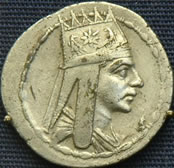
Tetradrachma of Tigran II the Great, King of Armenia (ruled 95 BC–55 BC),
with an image of Tigran wearing the Armenian Crown (Armenian royal tiara).
Indeed, the Bagratids played a special role in Armenia’s history. The Kingdom of Armenia was established around 600 BC, under Armenia’s native Ervanduni Dynasty (Orontids, in Greco-Latin sources), and after the breakup of the Kingdom of Ararat, also known as Urartu (1000-600 BC). Armenia’s power reached its height between 95 and 66 BC, under Tigran II the Great, who represented the Artashesian line of Armenian kings (Artaxiads, in Greco-Latin sources). Tigran II successfully fought against the Roman Empire, and his enormous kingdom bridged the Caspian and Mediterranean seas.
However, eighty six years after becoming the world’s first Christian state (in 301 AD), Armenia was partitioned between Romans and Persians. Its eastern part became a semi-independent kingdom, and then, temporarily, part of the Sassanid Persia. In the seventh century, Armenia was conquered by the Arab Caliphate. When the Caliphate weakened and retreated, the Kingdom of Armenia was reestablished, and Prince Ashot I Bagratuni (Bagratid)—recognized as the King of Armenians by both Baghdad (in 885) and Constantinople (in 886)—ascended to the throne. In an effort to unify the Armenian nation under one flag, the Bagratid kings subjugated other Armenian noble families by force or made them allies through arranged marriages. But in the mid-eleventh century, the Bagratid state fell under the attacks from Seljuk Turks. Armenian nobility chose to flee westward, and found refuge in the impregnable Cilician mountains, on the Mediterranean Sea. There, they established the Armenian Kingdom of Cilicia, a notable regional power that supported the First Crusade and existed as an independent state between 1078 and 1375.
Despite the fact that various smaller independent or semi-independent Armenian states—such as the Hasan Jalal Vahtangian’s own Kingdom of Khachen—continued their survival in well-fortified mountainous regions, the Bagratid Armenia was the last internationally-recognized Armenian power which controlled almost entire historical Armenian homeland. The Armenian Kingdom of Cilicia, which continued flourishing after the Bagratids fell, does not entirely count in that regard because of its location on the Mediterranean Sea, away from traditional Armenian lands.
The Hasan-Jalalians: Descendents of Hayk the Forefather
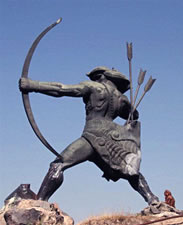
A monument in Yerevan dedicated to Hayk Nahapet (Hayk the Forefather), the legendary and eponymous progenitor of the Armenian people. Hasan Jalal Vahtangian, patron of the Gandzasar Monastery, claimed a direct lineage to Hayk through his Arranshahik ancestors.
While the Hasan-Jalalians’ royal origin is of tremendous historical and political value, an even more interesting fact is that their bloodline stretches back all the way to the world of Biblical patriarchs and epic heroes of the ancient world.
Hasan Jalal Vahtangian’s direct ancestors from the male line derived from an ancient noble clan called Arranshahiks (Armenians: Առանշահիկներ) who ruled eastern provinces of Armenia since very early times.
Arranshahiks, whose name means “shahs” (monarchs) of Arran’s lineage,” are one of the world’s oldest princely houses. They claimed a direct connection to early Armenian ancestral patriarchs, Hayk Nahapet and his grandson Sisak, and through them—to the legendary characters of the Old Testament, including Japheth, and, ultimately, Noah.
The most famous early Arranshahik monarch was Vachagan II the Pious, who lived in the 5th century and is credited for entrenching Christianity in Armenia’s eastern provinces, building numerous churches in Artsakh and Utik, and producing Armenia’s first known constitutional edict called “The Canons of Aghven.” King Vachagan’s grave, in the St. Yeghishe Monastery (located 30 miles north of Gandzasar) has for centuries been a key venue for pilgrimage of Artsakh’s Armenians.
Movses Kaghankatvatsi, the seventh century’s Armenian historian of Artsakh and Utik, tells the story of how the house of Arranshahiks came into being. In his seminal work “History of the Land of Aghvank,” Kaghankatvatsi repeats a legend originally reported by Movses Khorenatsi—the fifth century author of the “History of Armenia,” who is celebrated as the “father of Armenian history.”
According to Khorenatsi, the eponymous founder of this dynasty was Arran, a descendant of Patriarch Sisak (the direct ancestor of the Syuni (Syunid) princely clan). The traditional domain of the Siunids was the province of Syunik, the larger part of which now constitutes the province (marz) of Syunik in the Republic of Armenia.
Legends state that Sisak was a great-grandson of Hayk Nahapet (Armenian: Հայկ Նահապետ; also called Hayk the Titan: Հայկ Դյուցազուն). It is in Hayk’s memory that Armenians call themselves “Hye” (Armenian: Հայ, pronounced: “high”), and their country—“Hayq” or “Hayastan.”
The story of how Vagharshak I, King of Armenia, entrusted to Arran the control over the northeast extremity of his kingdom, is found in Chapter Four of Book One of the “History of the Land of Aghvank” and in Chapter Five of Khorenatsi’s “History of Armenia:”
“During the establishment of order for the northern inhabitants, [King Vagharshak] summoned the representatives of the wild tribes living on the northern plain as well as at the foothills of the Caucasus Mountains … and commanded them to stop brigandry and treachery, and to pay royal dues. Then the King appointed chieftains and rulers for them, and chose certain Arran to head them all, a man from the family of Sisak, one of the descendents of Japheth, who inherited the plains and mountains of the land of Aghvank.”
Later in the text, Kaghankatvatsi again highlights Arranshahiks’ connection to Patriarch Hayk Nahapet. When writing about the bloody conflict between the native Arranshahiks and the clan of Mihranians (Mihranids)—Armenian-assimilated feudal lords from Persia who invaded Utik’s county of Gardman in the Middle Ages and for some time suppressed its original rulers—Kaghankatvatsi calls Arranshahiks “a Haykazian dynasty,” i.e. deriving from Hayk. Kirakos Gandzaketsi, the 13th century author of the “History of Armenia,” similarly affirms that kings of Aghvank— Arran, Vachagan, Vache, Urnair and others—all descended from Hayk. [2]
The legend about Hayk is central to ethnic mythology and historical identity of the Armenian people. Movses Khorenatsi’s fifth century narrative describes Hayk as a titan, a leader of his tribe and a person of extraordinary physical features and martial skills. Hayk is postulated to be a grandson of Japheth, and, therefore, a grand-grandson of Noah.
Khorenatsi-told legend catches Hayk away from his homeland, in Babylon, the realm of the great king Bel (Nimrod), and the first city to be built after the Great Flood. When Hayk leaves Babylon and reestablishes in Armenia, Bel attempts to conquer Hayk’s domain, but proud Hayk refuses to submit. In an epic battle that occurred southeast of the Lake Van, Hayk slays Bel with a three-pronged arrow, sending the enormous Babylonian army into disarray. This victory confirms Hayk as the founding father of the Armenian people.
The Hasan-Jalalians: Mysterious Symbols
Gandzasar’s Cathedral of St. John serves as burial ground for Hasan Jalal Vahtangian and other princes and bishops of his lineage. The tomb of Hasan Jalal is located in front of the entrance to the main chamber of the cathedral, in the vestibule of the gavit (narthex).
The tombstone is carved from a solid piece of white marble. It is decorated with three large circular carvings: the Hexagram (“Star”) of King David which contains in its center an image of a swirl-styled Wheel of Eternity—an ancient Indo-Aryan symbol used widely by Armenians; the Wheel is supported by six pieces of vegetable decor, two of which represent fleur-de-lis (French lilies). This curious compound ornament is found in some other parts of historical Armenia where princely families related to Hasan Jalal’s Arranshahik clan held power.
The second circle is organized as a 16-beam star. It is not entirely clear what it represents but it looks like a combination of the East Asian version of the Wheel of Eternity (such as India ’s Ashoka Chakra) and Macedonia ’s 16-ray Star of Vergina.
The third circle is what is known in Armenian art history as the “Sun” (Armenian: արև) an ornamented and, sometimes, protuberant sphere commonly found in the lower parts of khachkars (unique-to-Armenia stone monuments with large carving of a Christian cross). The Sun is thought to be one of many rudiments of the sun-worshipping creed of ancient Armenians, which were preserved in Armenia’s Christian art with a tacit consent of the Church.
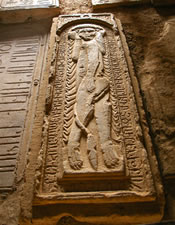
Tomb of Elikum III Orbelian, dated 1300, inside the Chapel of St. Gregory of the Noravank Monastery, Province of Vayots Dzor, Republic of Armenia. Elikum was the son of Prince Tarsaich Orbelian of Syunik who married one of Hasan Jalal’s daughters — Princess Mina.
The tombstone contains the following inscription in Old Church Armenian (Grabar): "ԱՅՍ է ՀԱՆԳԻՍՏ ՄԵԾԻՆ ՋԱԼԱԼԻՆ: ԱՂԱԻԹՍ ՅԻՇԵՑԵՔ։ ԹՎ ՊՁ. It reads: “Here Rests Great Jalal; Remember Him In Your Prayers; Year 1431.”
The Star of David and other elements of the curious ornament from Hasan Jalal’s tombstone are found in the province of Syunik as well, such as at the Tsaghatz-Kar Monastery in Vayots Dzor—the domain of the Orbelian and Hahbakian-Proshian princely clans which related to Hasan Jalal’s Vahtangian line of nobles.
Undoubtedly, the most mysterious of all of Vayots Dzor’s memorials is the tomb of Elikum III Orbelian. Elikum was the son of Tarsaich Orbelian who married one of Hasan Jalal’s daughters, Princess Mina. Elikum’s tomb, dated 1300, is inside the Chapel of St. Gregory, at the Noravank Monastery (in the present-day province of Vayots Dzor, Republic of Armenia). The mysterious image of a large anthropomorphic Lioness is masterfully engraved on Elikum’s tombstone. The human-looking hands and feet of the Lioness have long claws, a nimbus shines above her head, and a long tail hangs gently between her legs. No one could so far come with a definitive conclusion what the Lioness was meant to symbolize.
The Hasan-Jalalian Dynasty Today
After Hasan Jalal’s martyrdom in Persia, in 1261, his descendants, who began calling themselves Hasan-Jalalians in memory of their famous forefather, split into two separate but intermingling branches. The clerical branch treated the Holy See of Gandzasar as their ancestral domain, through the 20th century. The princely branch continued as landed nobles of Khachen: as princes and, later, as meliks (dukes) and beks (lower-class gentry).
In the 21st century, many of Hasan Jalal’s descendents still reside in the town of Vank, located at the foothills of Mount Gandzasar, and in Stepanakert—capital of the Nagorno Karabakh Republic. Some of them, living in Armenia, Russia and the United States, achieved tremendous success in business, science and arts.
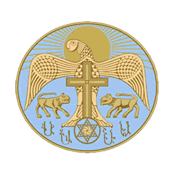
Emblem of the Hasan-Jalalian Charitable Foundation established in Yerevan to consolidate Hasan-Jalalian descendents and promote awareness of Gandzasar’s cultural and political significance.
One direct representative of Hasan-Jalalians is Levon G. Airapetian, a Soviet-era oilman and renowned philanthropist based in Russia. The Airapetian family financed the most recent comprehensive restoration program at the Gandzasar Monastery, carried out between 2000 and 2002. Airapetian also established a large wood-processing factory in Vank that provides much needed employment to the Nagorno Karabakh’s impoverished population. Currently, Airapetian joined forces with the Armenia Fund Inc. to invest in the construction of a dam on the River Khachenaget and related irrigation system. Airapetian’s daughter, Elena Airapetian, is a successful US-based investor banker who is well aware of her unique heritage.
In 2007, some members of the Hasan-Jalalian family established in Yerevan the Hasan-Jalalians Charitable Foundation whose purpose is to consolidate the Hasan-Jalalian descendents and promote awareness of Gandzasar’s cultural and political significance.















